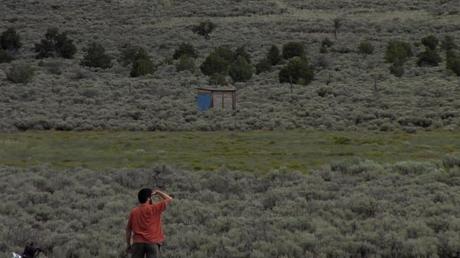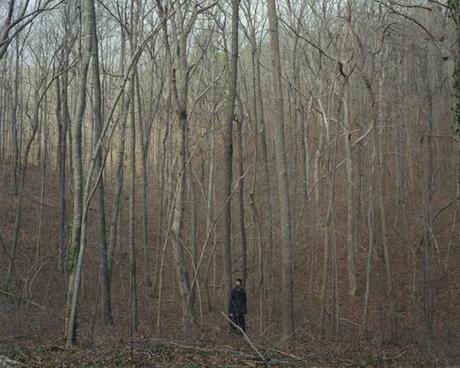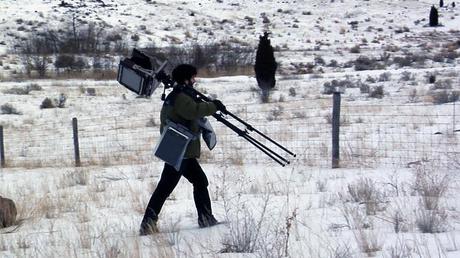Somewhere to Disappear, directed by Laure Flammerion and Arnaud Uyttenhove, is a documentary following renowned photographer Alec Soth as he travels the US in search of modern-day recluses and hermits to photograph for his book project, “Broken Manual.” On the surface the film is simply a portrait of the artist at work, shedding light on Soth’s intent and processes. As it progresses, however, it becomes something much more obscure and thematically rich, a comment on the need for connection between people and the actual impossibility of total removal from society. Possessed of both a rich affirmation of humanity and a crippling loneliness, the film becomes synchronous with Soth’s project while still maintaining its own perspective.

Flammerion and Uyttenhove disguise their film as something of a road movie, where the journey is of far greater importance than the destination. The idea of expanse haunts every highway. The filmmakers follow Soth for the better part of a year, silently observing him as he seeks out, interviews, and sometimes photographs an assortment of men who have chosen to go “off the grid”. I got the impression Soth spent more time talking with these people than he did photographing them; the tremendous vulnerabilities he was able to capture in his portraits suggests his subjects’ relative comfort with him. Soth wants to get at “the idea of escape,” to try and understand what he calls “the desire to run away”; the film serves as a document of that quest as well as one of Soth’s own removal as he ventures further into fringe existence.
Much of the film’s point is delivered via indirect interview. We travel alongside Soth as he drives cross-country, seemingly endlessly, trying to convey what it is he’s looking for and what he’s trying to get out of his encounters. Soth is gentle and soft-spoken, with a genuine friendliness and curiousity that helps his subjects open up to him. A good part of the film is given over to Soth’s encounters with the men he photographs; their experiences and opinions speak as much to the film’s intent as Soth’s, perhaps even more so. There is a suggestion that removal from society is a natural extension of psychological difficulties; every subject the photographer meets bears some sort of deep mental scarring. Many are conspiracy theorists, convinced of outside persecution and haunted by paranoia. Others have extremely violent and abusive pasts. These are broken, shattered human beings, rejected by society and forced to carve their own meanings out of the remaining constructs. Their lives are built on fractures, reductions, and fantasies. Soth allows that “people need space,” as one subject tells him, but he’s also struck by the “desperate need for love” that he sees in all of the men. This need to be alone versus the very basic human need for contact and understanding becomes the crux of both “Broken Manual” and Somewhere to Disappear.

The most impressive aspect of the film, though, is how successfully Flammerion and Uyttenhove incorporate Soth’s artistic and thematic aesthetic into their work. The cinematography reflects Soth’s work to the point that it seems as though Soth himself photographed the film. From the moment the picture opens we’re struck by an incredible sense of loneliness, as though we’re slowly moving through a void, trying to arrive at something that’s been very carefully hidden away. History is a betrayal, a record of growing sorrows across a passage of time. The dream life of our shared past is a haze of crumbling minutiae and rank nostalghia. Soth’s photography is often concerned with a sort of decay and sadness; his landscapes as well as his portraits speak to a kind of disregard, or of a collective forgetfulness. Something is missing from the picture; something has been hollowed out of the spaces. Soth’s work often feels like a lament, and the film mirrors this beautifully, giving us massive long takes of expansive landscapes showcasing an elegiac and majestic emptiness. There is ample room to hide, to fade, to become memory. These landscapes completely dwarf any notion of civilization; the men Soth finds living among these forgotten topographies seem like they exist at the absolute ends of the earth.
“Do people scare you?” Soth asks a young man he encounters living deep in the woods. “Did we scare you when you saw us?” The young man nods shyly, nearly cowering as he tries to explain his feelings to the photographer. Language becomes failure. Only the emotion is understandable. Eventually he leads Soth to a path deep amongst the trees, a lonely overgrown trail that speaks to the idea of fear and solitude better than words ever could. This path is where the young man feels safest; this leafy patch of void is sanctuary against reality. Later Soth meets a kind, gentle, and tremendously expressive man named Garth living in the foothills outside of Hollywood. Garth cares for an assortment of horses and other young runaways looking for help. Soth spends an entire day with him, listening to Garth’s views on life, philosophy, and what his isolation has come to mean to him. Garth gives of himself freely and endlessly; he “isn’t pretending to be anything else,” as Soth puts it. Soth is deeply moved by his experience with Garth, so much so that he is unable to take any photographs. The project becomes secondary to connection. The hyper-reality of what Soth is trying to document is dawning on him. “I just can’t process it,” he says, staring out into the vast Hollywood wasteland. “I need time to take it all in.”

The film never runs from the human element of what it’s documenting. Alec Soth is obviously affected profoundly by the people he meets; the need for kindness and affection that removal ultimately demands seems completely at odds with what Soth had initially hoped to capture. These men (and they are all men, according to Soth at the Minneapolis screening I attended) have not chosen loneliness-they have only chosen less. The filmmakers allow us to witness Soth’s considerations and emotional reactions across his journey. From a humble beginning of voyeuristically photographing a stranger from the recess of a warehouse building to the utter inability to snap one photograph of Garth and his home, Soth arrives at a deep understanding of privacy, of what can and cannot be shared with the world. The original desire to express in photographs “the idea of escape” instead becomes a testament to its impossibility. “It’s all a fantasy,” Soth concludes wistfully. None of us can ever truly disappear.
Somewhere to Disappear is a wonderful film. It serves as both a document and a piece of artwork, as mysterious and lonely as Alec Soth’s own photography. It’s difficult for me not to consider Somewhere to Disappear as a necessary companion piece to Soth’s “Broken Manual”; the two works comment on one another so effectively it seems as though they were conceived as such. Flammerion and Uyttenhove have presented a portrait of the lost wanting to be found, a beautiful and deeply poetic look at human connection that easily transcends the idea of documentary in the same manner as the films of Werner Herzog (Soth’s inability to photograph certain subjects feels similar to Herzog’s stance in The White Diamond). Flammerion and Uyttenhove suggest that loneliness is not an inevitability; much like Soth, they find hope in small kindnesses and our very human ability to be moved by what we witness. The connections are rooted deep in our collective unconscious. Somewhere to Disappear is a reflection of that hope, as well as a stunning piece of cinematic art.
Cory Strand 2/7/12
For more on Somewhere to Disappear: http://www.somewheretodisappearthefilm.com/

